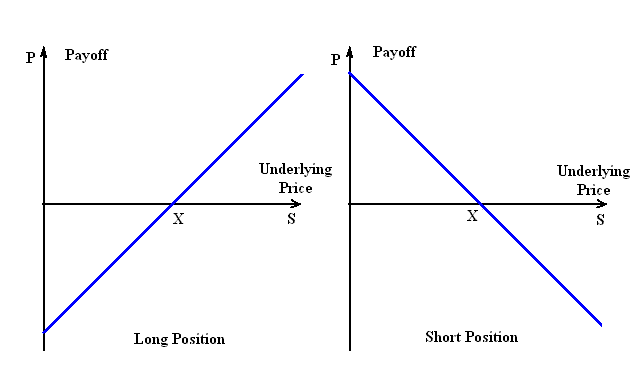

The price specified in forward contract is called delivery price or price at maturity. A forward contract is settled at maturity, when the holder of short position delivers the security to the holder of the long position in return for cash amount equal to the delivery price. The value of forward contract is determined by the market price of the underlying security. The forward price is defined as the delivery price which would make the forward contract to have zero value. It follows that the forward and delivery prices are equal at the time the contract entered into and it costs nothing to take either a long or a short position. As time passes the underlying security price changes which entails the change of forward contract value(price).

The payoff from a long position in a forward contract is
where S is a spot price of the security at time of contract maturity, X is the delivery price. Similarly, the payoff from a short position is
For example, let's say the current price of the stock is $80.00 and we entered in forward contract to buy this stock in 3 months time for $81.00 (that means we hope that price will not fall lower than $81.00). If after three months price is more than $81.00, let's say $83.00, than we can buy the same stock for $81.00 (as stated by forward contract) and after reselling it on the market our payoff will be
If at forward maturity the stock price falls to $78.00, than our loss will be
The graphs above illustrate the forward contract payoff patterns for long and short positions.
The important point to emphesize is that an option gives the holder the right to do something but the holder doesn't have to exercise this right. This distinguishes options from forwards and futures, where the holder is obligated to buy or sell the underlying security.

Long Call: P = S - X - OP Short Call: P = X - S + OP Long Put: P = X - S - OP Short Put: P = S - X + OPFor example, let's say the stock price is $50.00, we bought European call option with strike $53.00 and paid $2.00 for this option. If option price is less than $53.00, we will not exercise the option to buy the stock, because it doesn't make sense to buy security for higher price than it costs on the market. In this case we lose all initial investment equal to the option price $2.00. If stock price is more than $53.00, we will exercise the option. For example if the stock price is $56.00, after exercising the option and immediately reselling the acquired stock our profit will be:
if the stock price is $54.00, than the profit is:
As we see in latter case we lose money. The reason is that increase of stock price just by $1.00 above the strike ($53.00) doesn't cover our initial investment of $2.00, although we still exercise the option to recover at least $1.00 of initial investment. If the stock price at exercise time is $55.00 than we exercise the option to cover our initial expenses(equal to option price):
This latter case corresponds to option graph intersection point with
horizontal axis on the drawing above.
